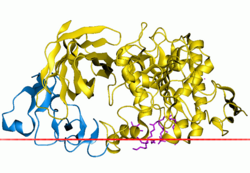Human pancreatic lipase

Complex of human pancreatic lipase with colipase
|
|||||||||
| Identifiers | |||||||||
|---|---|---|---|---|---|---|---|---|---|
| Symbol | Lipase | ||||||||
| Pfam | PF00151 | ||||||||
| InterPro | IPR013818 | ||||||||
| PROSITE | PDOC00110 | ||||||||
| SCOP | 1lpa | ||||||||
| SUPERFAMILY | 1lpa | ||||||||
| OPM protein | 1lpa | ||||||||
|
|||||||||
| Available protein structures: | |
|---|---|
| Pfam | structures |
| PDB | RCSB PDB; PDBe; PDBj |
| PDBsum | structure summary |
Triglyceride lipases (EC 3.1.1.3) are a family of lipolytic enzymes that hydrolyse ester linkages of triglycerides. Lipases are widely distributed in animals, plants and prokaryotes.
At least three tissue-specific isozymes exist in higher vertebrates, pancreatic, hepatic and gastric/lingual. These lipases are closely related to each other and to lipoprotein lipase (EC 3.1.1.34), which hydrolyses triglycerides of chylomicrons and very low density lipoproteins (VLDL).
The most conserved region in all these proteins is centred on a serine residue which has been shown to participate, with an histidine and an aspartic acid residue, in a charge relay system. Such a region is also present in lipases of prokaryotic origin and in lecithin-cholesterol acyltransferase (EC 2.3.1.43) (LCAT), which catalyzes fatty acid transfer between phosphatidylcholine and cholesterol.
Pancreatic lipase, also known as pancreatic triacylglycerol lipase, is an enzyme secreted from the pancreas. As the primary lipase enzyme that hydrolyzes (breaks down) dietary fat molecules in the human digestive system, it is one of the main digestive enzymes, converting triglyceride substrates found in ingested oils to monoglycerides and free fatty acids.
Bile salts secreted from the liver and stored in gallbladder are released into the duodenum, where they coat and emulsify large fat droplets into smaller droplets, thus increasing the overall surface area of the fat, which allows the lipase to break apart the fat more effectively. The resulting monomers (2 free fatty acids and one 2-monoacylglycerol) are then moved by way of peristalsis along the small intestine to be absorbed into the lymphatic system by a specialized vessel called a lacteal. This protein belongs to the pancreatic lipase family.
...
Wikipedia
